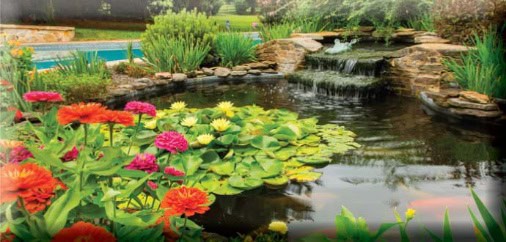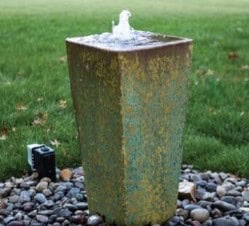How to Winterize Ponds and Other Water Features
December 20, 2016
Ponds, water fountains, waterfalls and other water features should be properly winterized in order to protect and prevent freezing pipes and cracking foundations during the winter. As a homeowner, you invest a great deal of money on these ambient features. Protect your and investment by properly winterizing your pond today.
Every homeowner has a unique landscape that requires an individualized approach. Your method will depend on the exact features of your pond or pool. If you have a very intricate pond eco-system, you should consult an expert for specialized winterization methods. Otherwise, the following steps will help ensure your water is property winterized.
Tips to Winterize Ponds
DiSabatino Landscaping advises that you complete the following steps to prepare ponds and other water features for the winter months ahead:
Getting your pond ready for winter begins in the fall and water temperature is a determining factor of when is the right time to make changes, so you’ll first need a thermometer to determine the best course of treatment.
Living ponds have a variety of factors that need to be addressed:
- Debris Control: Clean out all debris, leaves and silt from the bottom of your pond. The cleaner you can get the pond before freezing weather comes, the healthier your pond will be throughout the winter. Ponds need to be covered with netting in the fall. This netting should be well above the surface so leaves can be easily cleaned. Use a fine-weave aquarium net to sift out excess sludge and debris.
- Water Change: A water change can be done anytime, but it is much more comfortable if it’s done before the water reaches 60◦ Remember to use dechlorinator if your water contains chlorine.
- De-Icer: Use a de-icer to keep a section of your pond open to allow oxygenation and gas exchange. This does not warm the overall water temperature of your pond. A de-icer simply allows toxic gasses to be released and oxygen to enter the pond.
- Pump Care: When temperatures drop below 40°F, the main pump should be removed and filters thoroughly cleaned. Do not leave the pump running on the bottom of the pond. It will lower the temperature of the entire pond by disrupting the natural thermal layers of the pond water as well as adding extreme stress on pond fish.
- Plant Care: Trim and remove any dying plant material as it appears to avoid debris build-up. In this area, bring inside all tropical plants and set all hardy water lilies to the bottom, if the pond is deep enough to keep them from freezing to the bottom.
- Fish Care: Depending on the water temperature will determine what food you feed you fish. Cooler temperatures make it harder for fish to digest food properly. Though it is important for fish to bulk up during the winter months, it is imperative that they not be overfed. As this is a complicated topic, here are more intricate instructions on fish care.
Winterizing/Freezing Conditions for Other Water Features:
During periods with freezing conditions, it is not recommended to keep the fountain running. When only light freezing temperatures occur at night, the fountain can be run continuously. The flow of water will keep the fountain from freezing. Periods of light frost at night occur occasionally in the South or during fall or spring in the North.
 When freezing temperatures are expected during a continuous period of time, experts recommend turning off the pump and letting the fountain feature (especially the vases) drain completely. In areas with freezing winter conditions, it is recommended to actually store the vases in a dry area or to cover the opening of the vases to keep water, ice and snow from accumulating in the vase. Water in the vases can cause the material to crack in freezing temperatures.
When freezing temperatures are expected during a continuous period of time, experts recommend turning off the pump and letting the fountain feature (especially the vases) drain completely. In areas with freezing winter conditions, it is recommended to actually store the vases in a dry area or to cover the opening of the vases to keep water, ice and snow from accumulating in the vase. Water in the vases can cause the material to crack in freezing temperatures.
Fountain vases with installed lights typically drain automatically once the pump is turned off through a small hole in the bottom. In case the vase does not drain it should be emptied by tipping it over, or by syphoning water and pump can remain in the basin.
DiSabatino Landscaping offers a wide range of styles and settings to enhance the beauty of your home. Custom water features can serve as the focal point of landscape while creating a natural stress-relieving environment. Contact us at (302) 764-0408 to set up a complimentary consultation or visit us on the web at www.DiSabatinoInc.com.